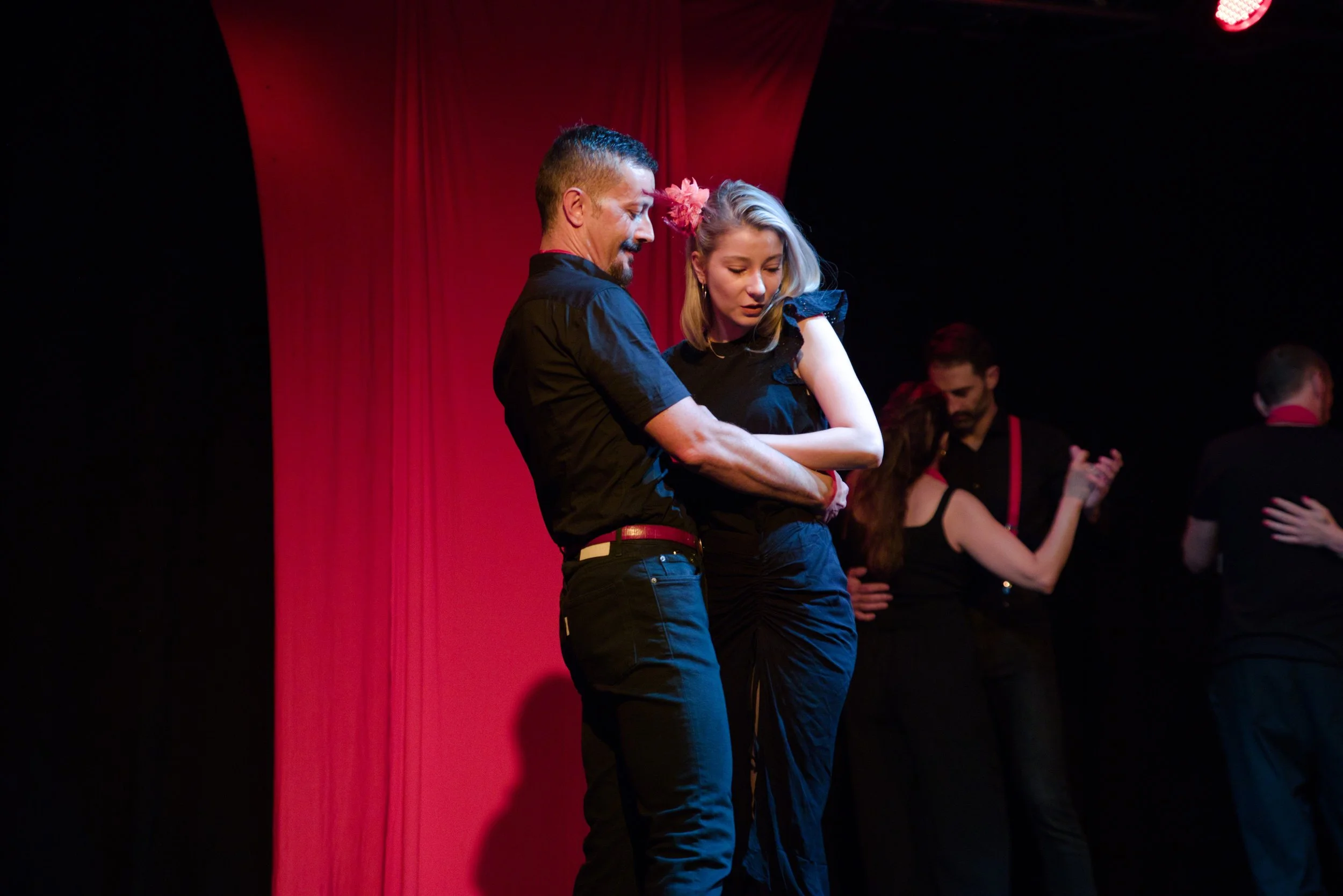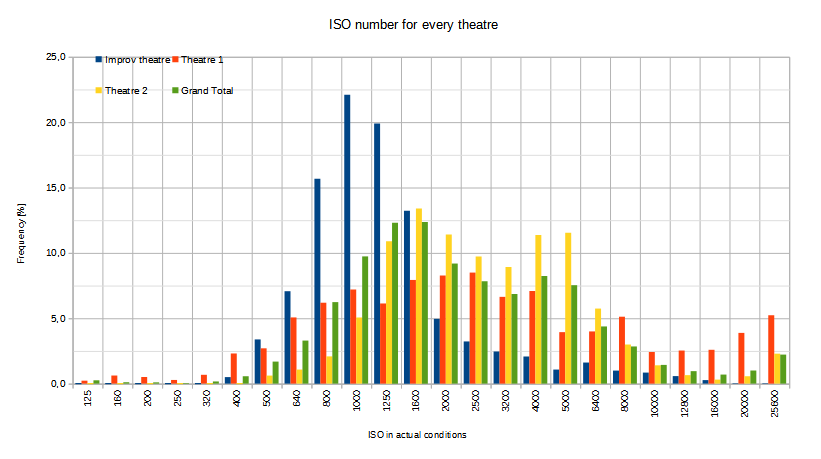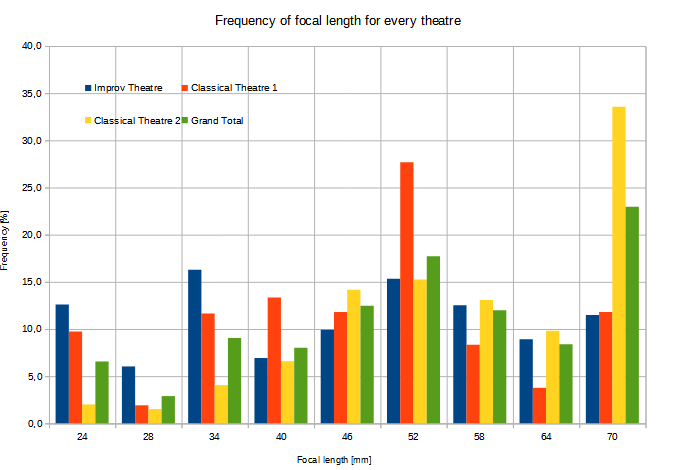The tyranny of light
The effect of light on stage photography
The verb "to photograph" was invented during the nineteenth century from words of Greek origin, meaning "to write with light". The importance that light has on the picture being taken cannot be overstated; when natural light is the only possible source of light, photographic sessions are usually planned in advance in order to catch the best possible light for the shot, whether that might be dusk or dawn or an early morning light. Landscape photographers need to have a good knowledge of the territory they are willing to represent, and also a practical knowledge of natural phaenomena such as sunrise time, moon rising time, tides, and auroras. The good photographer will study the best moment in the day for the picture he would like to take, plan ahead, and hope the weather will hold and allow the best possible outcome.
Things are quite different on a stage, whether the event taking place is a play, a ballet or a concert. In such cases, the photographer is never in control of the lighting conditions and cannot anticipate or guess the lighting setup. The best action a photographer can take in order to be prepared for the show is following rehearsals and in particular the dressed rehearsal. The choice of lights is made by a director or lighting manager, with the purpose of adding mood to the action on stage for the live audience. Lights cannot be designed for photographic images, otherwise we would call the performance "cinema" instead of "theatre". It is important that directors use the lighting tools available to them to add meaning and depth to the action; the image being created on stage should have qualities that can be appreciated live, and not in pictures: for instance, a blinding light or a backlit scene or many different spots of colours are surely going to have a powerful impact for a live audience, yet will be difficult to represent in a picture. As a consequence, the photographer will often be in a position where lights are too dim or there is little contrast between actors and background, with the consequence that the pictures taken are less than optimal or even unpleasant.
But if directors will be directors, how can photographers produce good images in difficult lighting conditions? Let us look at an example of how a difficult lighting condition can be rendered as a good picture. The examples here are part of the pictures from "Sangue" by Officine Guitti. The title translates in English as “Blood”, and it is a collection of stories about love, passion, folly and violence. During all the play, the actors were literally bathed in a strong red light that sets a dramatic mood, but even if I am sure this is a good lighting choice, as a photographer I was concerned that the red light would strongly affect my pictures. I am focusing on the picture below because it is quite representative of some common difficulties found in stage photography.
Straight out of camera
By looking at the picture above, the red light looks overwhelming at first sight, yet all the shadow details are still visible, in particular the folds of her dress and of his trousers. The expressions of both faces are completely readable, their hair is in focus. On the whole, we might be looking at a good picture. On the negative side: the actors in the background are not completely distinct from the back wall and her arm is too bright so that some details are lost and will not be retrieved.
Let us try to set the white balance taking her dress as reference and see what happens (colour temperature=1830 K, hue=1.1).
Red light is almost canceled - colour temperature=1830 K, hue=1.1
It is clear that the red light can be almost canceled by finding the right colour temperature; all the skin tones appear more natural than before, for the characters in the foreground as well as for the ones in the background. I think this colour temperature is not the proper one because the light tones on her dress and his shirt appear bluer than I would expect. Now it is time to address a different question: am I willing to remove the red colour cast from the picture? I do not think this is the right choice for this picture because the second picture is much less dramatic than the original one, and completely lacks the sense of anticipation and impending danger the red light brings to the scene. I will try to find a happy medium between the two, for instance something like
Keeping a slightly red colour cast - colour temperature = 2100 K
... and desaturate the whole picture in order to retrieve some details.
Final choice, same colour temp as before, desaturating curves
This last image is the best I could come up with: the details in the foreground characters are there, the characters in the background are discernible (at least, more than before). Only defect still visible is the lack of details in her arm, but this cannot be helped in any way because of the original picture was too bright in that particular spot. The picture was deliberately underexposed by one stop, but this was not enough to prevent bright spots in some areas of the frame.
Gear does not matter - until it does
Thoughts about the right tools for the job
As an avid reader of photography articles on many websites, I have many times come across the notion that "gear does not matter", which I hold to be true... within some limits.
When I was starting taking photographs I was drawn by a local theatre where amateur performers allowed photographers to take pictures during shows or dressed rehearsals. I was using a digital camera that came to market 4-5 years before (an Olympus E-410). Needless to say, the low light performance of that camera was quite ugly and I did not dare use the highest ISO numbers because the sensor would superimpose a multitude of horizontal stripes on my picture. It was the consequence of bringing an entry level camera already showing signs of age to a situation where only the newest and shiniest cameras could guarantee good results. But if gear does not matter, what was I supposed to do?
I was quite aware that I should increase the amount of light on the sensor, and as a consequence I replaced my entry level kit zoom lens with a manual focus prime lens. This new lens was surely a step in the right direction, but at the same time it brought a new difficulty: even if many more pictures could be taken in low light, many of them were out of focus because of the lack of feedback from the camera. And to complicate things, manual focus used to give me literal headaches because I was always very attentively staring at a smallish viewfinder and making tiny adjustments to the focus knob, keeping as still as possible and controlling my breathing... often on Friday evening after work.
After that, I finally decided to stop punishing myself and jumped on the ship of high ISO and fast autofocus. I was using a Canon 5D mk ii (formerly used as display sample by a local shop), and suddenly my pictures improved. With the previous camera I could barely keep 10% of the pictures I was shooting. Now after some fiddling with the menus and proper configuration, my new camera allowed me to keep 80% of the pictures I was shooting. My main concerns were completely different from before, my aim was trying to capture relevant moments during the play, an interaction between actors, a choreographed action that lends itself to an interesting composition, a scene with vibrant colours or lights... this was the moment when the camera did not matter (anymore), and I could be free to concentrate on the action before my eyes.
As of today I have no doubt that the content you produce as a photographer is the result of your vision and not the result of your camera having the latest and greatest capabilities because gear does not matter. The whole point of thinking "gear does not matter" is to give emphasis to the idea that you as the photographer should invest your time in learning, experimenting, creating and practicing new techniques with what you already have. Do take photographs as if your results did not depend on the gear you have, but please check once in a while whether your camera is hindering your creative possibilities: stage photography is a technically demanding genre after all.
https://digital-photography-school.com/why-your-camera-gear-doesnt-matter/
Sean Tucker - How I approach Buying Cameras (avoiding the gear traps)
https://www.diyphotography.net/is-does-gear-matter-the-most-pointless-argument-in-photography/
Exif data - a statistical approach
A statistician’s perspective on pictures taken
I have been recently wondering if my pictures would benefit from a change in perspective, meaning a lens with a different focal length and aperture. I am considering a tele lens because I am thinking of creating pictures more similar to portraits, but this would require a lens with a longer reach... which one? a fast one (f=2.8), a fast-ish one (f=4), or a not so fast lens (5.6-6.3)? If I had a fast-ish lens, would the increase in ISO compensate for the lesser amount of light or should I expect a reduction in image quality? Besides, how often have I used the maximum focal length of my zoom range?
With all these questions in my mind, I addressed this matter the way I kow better: by looking at data.
First of all, I set the goal of retrieving all the picture parameters that are stored in exif data, for every picture of every play in 2022. Then I placed all the results in a big fat excel file and looked at the data through pivot tables. Since the data is there, why not have a look at the mean ISO number for every play? Is there a correlation between ISO number and lighting? As always with data, one question usually leads to another question. I am throwing in this data analysis also about 30 pictures that were taken during a trip on the Dolomites (taken on a bright day of sunshine) as a proof that I can correctly identify the outlier in my data.
My first concern was to determine whether there is one theatre that consistently uses a higher or lower light intensity by looking at computed EV values. Without much surprise, it is clear that improvisational theatre usually takes place at a much more brightly lit stage than classical theatre... at least in my experience. For improv, at least 60% of the pictures range between 5.67 and 7, while for classical theatre the 80% of pictures ranges between 2.67-7.3 in one theatre, and 4-6.3 in another. There is also a significant difference between the range of EV values of the two different classical theatres, the first uses lights with much greater variety and uses lights to add depth to the scene, while the second one usually prefers less pronounced variations between scenes in the same play. As a side note, my holiday pictures outshine all the other pictures with 100% of the EV values between 12.3 and 13, definitely much brighter than any indoor lighting can achieve: even if this fact should not be surprising, it is and important confirmation that the EV data represent a real fact and can be trusted.
Let us have a look at how ISO values are distributed for all the pictures taken in the three different categories. Similarly to what we have noticed for EV values, there is a significant difference between improvisational theatre and classical theatre. The typical ISO values of the two classical theatres have a different spread but similar mean values.
Let us try to determine how the ISO number would have changed if I had used a f=4 lens for all the pictures. Since the actual pictures are mostly taken at f=2.8 or f=3.2, the simplest solution is adding one stop to the actual ISO number and accept 1/3 stop error in the results. As an alternative, it is possible to calculate, for every picture, the equivalent ISO at f=4 for that particular EV value. I have followed the latter approach for the sake of precision, and also because the increase in complexity is acceptable.
If we decide that image quality is acceptable for all the pictures at ISO 6400 and lower, the improvisational theatre pictures would be totally acceptable in at least 80% of the instances, while picture quality would certainly worsen for the classical theatre plays. In both cases, the average ISO number would become close to 4000 and the 80th percentile of the pictures would fall in the range 25600 - 10000, which is in both cases a visible drop in picture quality.
Let us assess which focal lengths are most frequent. Since these data range from 24 to 70 mm, and every possible value in this range is represented, data were aggregated by binning. This operation can affect the evaluation of the data, even if it is almost necessary to achieve an understanding of trends and use cases. Values 24 and 70 were assigned one bin each, since they fall exactly at the ends of the range; 27 and 29 were binned as 28 (curiously the value 28 never showed up), all the values from 31 to 67 were placed in 6 equally spaced bins. The data is more sparse and less straightforward to assess than the EV and ISO values, however if we look at the relative frequency of the focal lengths we can find some patterns. First of all, the wide and tele end of the zoom (24 mm and 70 mm) each make up a significant percentage of the overall pictures. By looking at cumulative frequencies, the mean value of the frequency distribution (the focal length intersecting cumulative freq = 50%) is 46-55 for all three theatres, but classical theatre 2 generally shows that more pictures are taken near the tele end of the zoom range. This can be explained by the greater distance of my usual shooting position from the stage than for the other two theatres. By looking at frequency histogram, it is quite clear that all three theatres have more than 15% of the pictures taken at 52 mm, which can be dictated by relative distance to the stage but also by personal preference. A possible interpretation of the focal range data from a photographic point of view is the following: even if my pictures are preferably taken at wide focal lengths, the zoom I am using might restrict creative choices because many pictures are taken at the end of the tele range. However, in the greatest majority of situations, the zoom I am using seems to be suited for the situations where it is used; this idea is corroborated by the fact that the mean focal length falls in the range 46-55 mm. It is also possible that the greatest occurrence of 46-55 mm could be caused by my personal preference because it allows a composition made of 3 or more people in the same frame.








